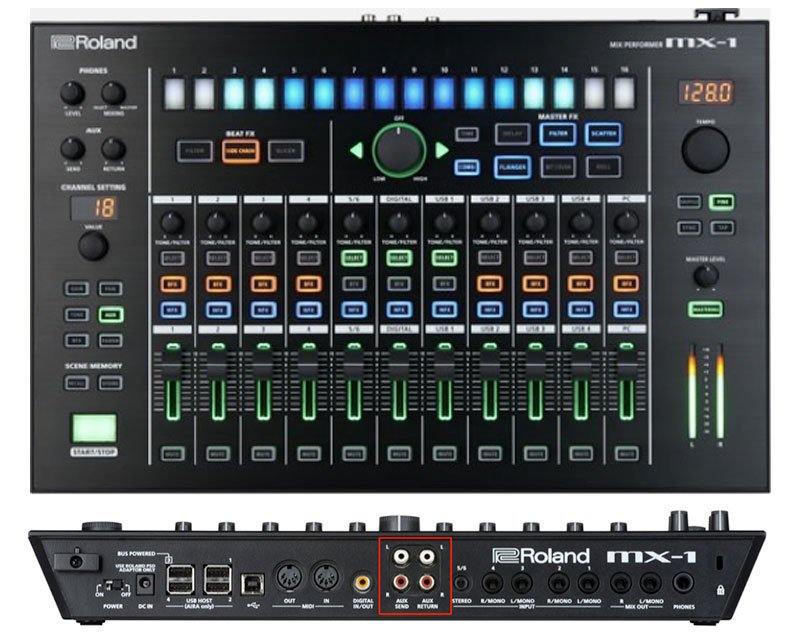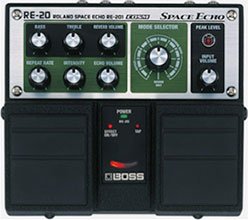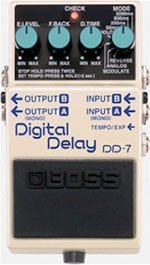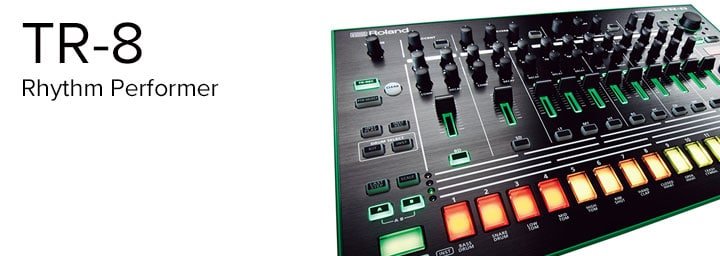Effects are a great way to expand the sounds of your drum machines. While you may never get tired of the classic sound of Roland drum machines, adding effects can take your rhythms to new and exciting places. To get the most out of your TR-8, make use of the expansive onboard effects, go deeper with the addition of guitar effects pedals or experiment with modular effects units. Over this 3 part series, we will look at the benefits of all approaches and in this article, we’ll demonstrate various ways to use your TR-8 with effects pedals.
Using effects pedals alongside your TR-8 drum machine can take it to new sonic realms. The ability to physically alter parameters with your hands can be vital when looking for that creative spark. Using unorthodox techniques to create and record sounds can help to differentiate your tracks from the sea of music being created by others around the world.
Contributed by Gareth Psaltis for the Roland Australia Blog
SETUP
There are many different ways to use effect pedals with the TR-8. No single method is “correct” and often, the method that some would consider wrong may be the technique that creates the most interesting sound! Here are a few different ways that you can set up your TR-8 to use with effects pedals.
1) Insert on the Master
Using pedals as an insert is a common method of use. Set up a chain of pedals (or one single pedal) between the MIX OUTPUT of your TR-8 and your speakers, headphones, or audio interface. Many compact pedals are mono only, so you will have to go from the L/MONO OUTPUT of the TR-8 into the pedal if that is the case.

2) Assignable Outs
Another option is to have specific drum sounds assigned to the ASSIGNABLE OUTS of the TR-8. You can then have pedal/s affecting those specifically chosen sounds (e.g. distortion only affecting hats/cymbals).
To route sounds to the assignable outputs, turn on the TR-8 while holding PTN SELECT. Notice when you hold variation A or B, the INST select buttons dim. While holding Variation A or B, press the INST select buttons to assign a drum to ASSIGNABLE OUT A or B. The remaining unassigned drums will be routed to MIX OUT by default and will not be affected by the pedal.

3) External Inputs
Using the assignable outputs with the external inputs of the TR-8 is an effective way to send your drum sounds through an effects pedal and return the sounds back into the TR-8. This is particularly useful if you desire to use effects pedals on specific TR-8 sounds. Any sound travelling through the TR-8’s assignable outputs will not be heard in the master mix. This means you can send specific drum sounds through an ASSIGNABLE OUT to the input of an effects pedal. You then return the output of that pedal (or chain of pedals) back into the EXT IN of the TR-8. The affected signal will now be heard in the master mix and the level can be controlled by the EXTERNAL IN knob. You can also sidechain and scatter this signal. If the pedal output is mono you will need to set the external inputs to mono. To make the external inputs mono:
- While holding down the PTN SELECT button, turn on the power. The START/STOP button will blink. If you decide not to change the settings, turn off the power.
- Use the TEMPO knob and the pads to change the settings. If INST [4] is lit, the external inputs are stereo. If it is unlit, they are both mono.
- Press the START/STOP button to save the settings. The settings will be saved, and the TR-8 will restart.

4) Send/Return to a Mixer
Using effects pedals as a send/return or an insert on your mixer. In this setup, you have more control over when your TR-8 (and any other) sound is affected by the pedals. It is possible to use effect pedals with the Roland MX-1, utilising its AUX SEND/AUX RETURN outputs and inputs. The AUX SEND/AUX RETURN slots are stereo, so it would be ideal to hook up a stereo unit such as the BOSS DD-500 or BOSS RE-20. The DD-500 is also able to MIDI sync to the tempo of the MX-1 and other MIDI units. The AUX send can be set to either Pre or Post-Fader.
This is also the best way to get the most out of your pedals, as it enables you to utilise the effect on a number of different sound sources and allows you to control the level of send for each individual instrument. This is a great way to heighten a live performance and can add depth and dimension to studio recordings.

DISTORTION/OVERDRIVE
Distortion is one of the most commonly used audio effects and for good reason! It can bring a sound to life, adding unique character or completely changing the tone. Different distortions and overdrives can have vastly differing effects on sound sources. This is especially true for drum sounds. A kick drum will react completely differently to a cymbal, when both are run through a distortion pedal.
It is important to spend time experimenting and researching which distortion will work best for your situation, as some pedals are better suited for specific instruments and techniques. Distortion can also be great for recreating the drum tones of your favourite electronic music of the past. You may have always wanted to create the kick drums of 90’s UK gabba and hardcore rave music, or the tape saturated TR-808 and TR-909 sounds found in lo-fi house music released today. Distortion pedals are great for exploring these sonic possibilities and taking your drum sounds to places they were not necessarily intended.
Drive vs Distortion
Overdrive pedals work to replicate the distorted sound of a slightly overdriven tube amplifier. Distortion pedals will heavily crush the signal, creating additional artefacts and harmonics. Speaking broadly, overdrive pedals are more commonly associated with the tones found in classic rock and blues, while distortion pedals are associated with heavier genres like hard rock, punk and metal. Heavy distortion can produce undesirable artefacts and compression, while lighter distortions and overdrives do not suffer from these dissonances and allow for more control of dynamics. Both are great for adding some dirt and grit to your drum sound.
Tips:
- Try adding and blending different distortions together to yield unexpected results from your drum tones.
- Keep in mind that distortion can reduce the bass frequencies of the sound. To counter this, pedals specifically designed for bass can have inbuilt equalising that boosts the bass frequencies. Some pedals have EQ settings, where you can boost the bass manually.
- Use a dry/wet control to mix the original signal with the distorted signal.
Below is a selection of BOSS distortion/overdrive pedals that work well with the TR-8. Remember, there are no rules, so get experimenting with different pedals and pedal combinations.
COMPRESSION
Compression is a vital effect that can help to bring the most out of your drum sound. It is used to flatten, fatten and boost the power of a drum track.
Compression is the process of reducing the dynamic range of an audio signal. This is achieved by reducing the louder parts of the signal, while boosting the quieter parts. Compression allows you to control signals with high transient peaks, which in turn allows you to raise the volume of the signal as a whole.
By ignoring ordinary rules, compression can also be used as a creative effect. Pushing a whole drum mix into a compressor can add a really powerful pumping effect to your rhythm track. Over-compressing a signal is a commonly used effect in a lot of EDM.
Parallel compression is a technique particularly suited to drums. The basic concept involves using the compressor as a send rather than an insert. The dry signal is combined with a compressed version of itself, with the two signals running in parallel. The result is an effect that allows you to retain some of the dynamic range of the original track, while also having that fuller, compressed sound.
As always, the rules are there to be broken. Typical controls on a compressor pedal include:
- Threshold – The compressor has no effect on the signal below the threshold level setting. Once a signal reaches the threshold, the compressor starts reducing that signal depending on the ratio.
- Ratio – The degree to which the compressor is reducing the dynamic range.
- Attack – The time it takes for the compressor to start working, once the threshold has been reached. If a fast attack setting is used, the gain of the signal will be reduced instantly.
- Release – The time in which the compressor returns to unity gain, after the input signal is below the threshold.
- Knee – The moment the compressor starts gain reduction.
- Make-up Gain – Boost control for the compressed signal.
- Output – Boost or attenuate the level of the signal output from the compressor
DELAY
Delay has been an integral part of electronic music since its inception. From tape loops in the 50’s, to the tape delay effect made famous by the dub and reggae pioneers, the influence delay has had on electronic music is immeasurable. Using delay with your drum machine can do much more than just adding a simple echo effect. Delay can be used to create movement, add intensity, mask, morph, and colour your sounds.
Stompbox delays are so diverse and can add so much to your studio or live setup. Most pedals allow you to adjust your delay to create flange/chorus type sounds, some delays can sync via MIDI to the tempo of your machines, while others recreate the unique tone of tape delay. Delay can give endless creative potential to your instruments.
Over the years, a significant number of BOSS pedals have been devoted to the delay effect. From 1978 to the present day, BOSS have created over 20 different stomp delay and echo stomp box pedals. For an intensive look into the history of delay pedals, check out our article ‘Echoes in Time’.
Below is a selection of BOSS delay pedals that produce amazing results with the TR-8.
DM-2W – Analog Delay
The DM-2W is BOSS’ premium analog delay pedal. It can act as a send/return on your mixer for live performance or as a tool for studio production. If you are after that authentic analog, dub-style delay, look no further. The FEEDBACK produces a delay that sounds warm, gritty and alive.
TE-2 – Tera Echo
The TE-2 produces a dynamic stereo effect that goes far beyond a traditional reverb or delay. Pairing it with your TR-8 can create wild results. The TE-2 does incredible things to pitched percussion like toms and the clav. Try recording a percussive sequence through the TE-2 and mess with the settings until you find a unique sound that appeals to you. The Tera Echo works well as an auxiliary send/return on your mixer to add ambience to your mix. It also sounds amazing when paired with a synthesizer.
 RE-20 Space Echo
The RE-20 is one of the most popular delay pedals for electronic musicians, due to its accurate reproduction of the classic tape delay effect. The RE-20 provides the classic sound of dub delay, recreating the tone of the famous Roland RE-201, with
the spacious, analog tone of the original Space Echo. The RE-20 combines the tone of vintage studio recordings with the added functionality and stability that compact BOSS pedals offer today.
The added bonus of TAP TEMPO means a live performer can sync the delay quickly and easily while performing with the tempo of the drum machine. Another trick is to quickly alter the delay TIME by punching in different tempos with your hand (or foot), creating interesting stuttering effects as the delay catches up with the new time. Turning the FEEDBACK knob past the 3 o’clock mark can get those great screaming delays found in analog tape delays. Playing with the FEEDBACK is great for developing interesting atmospheres, creating build-ups and drops during performance or just to add extra controlled noise to your mix.
RE-20 Space Echo
The RE-20 is one of the most popular delay pedals for electronic musicians, due to its accurate reproduction of the classic tape delay effect. The RE-20 provides the classic sound of dub delay, recreating the tone of the famous Roland RE-201, with
the spacious, analog tone of the original Space Echo. The RE-20 combines the tone of vintage studio recordings with the added functionality and stability that compact BOSS pedals offer today.
The added bonus of TAP TEMPO means a live performer can sync the delay quickly and easily while performing with the tempo of the drum machine. Another trick is to quickly alter the delay TIME by punching in different tempos with your hand (or foot), creating interesting stuttering effects as the delay catches up with the new time. Turning the FEEDBACK knob past the 3 o’clock mark can get those great screaming delays found in analog tape delays. Playing with the FEEDBACK is great for developing interesting atmospheres, creating build-ups and drops during performance or just to add extra controlled noise to your mix.  DD-7 – Digital Delay
The BOSS digital delay pedal range has been used extensively by electronic musicians and producers for years. Having been mainly used as an accompaniment to guitars and synthesizers, the DD-7 is equally useful as a send/return on your mixer or as a creative effect with its reverse effect and extremely short delay times.
US artist Container exploits the DD-7 to get completely out-of-this-world sounds. He uses a Roland MC505 to create driving rhythm tracks and adds the DD-7 to completely destroy the incoming signal. Many of his tracks feature the DD-7 as the main instrument, using its short delay times and feedback to create rhythmic noise. Check out his incredible Boiler Room performance below.
DD-7 – Digital Delay
The BOSS digital delay pedal range has been used extensively by electronic musicians and producers for years. Having been mainly used as an accompaniment to guitars and synthesizers, the DD-7 is equally useful as a send/return on your mixer or as a creative effect with its reverse effect and extremely short delay times.
US artist Container exploits the DD-7 to get completely out-of-this-world sounds. He uses a Roland MC505 to create driving rhythm tracks and adds the DD-7 to completely destroy the incoming signal. Many of his tracks feature the DD-7 as the main instrument, using its short delay times and feedback to create rhythmic noise. Check out his incredible Boiler Room performance below. MODULATION
Modulation effects were developed as a way of adding dimension, depth and movement to a sound. In electronics, modulation is defined as the process of varying properties of a waveform (carrier signal) with a modulating signal. Modulation effects can be used in a multitude of different ways and can bring a creative, unique edge to your drum sound.
Chorus works to simulate the slight variations in pitch, timbre and timing that occur when multiple players, or a choir, perform the same part. It is used to create a thicker, richer sound and can add subtle movement to a mix. The process of creating chorus is similar to phasing, though utilises a delay rather than multiple all-pass filters. An audio signal in split two, with one signal sent through a short delay and then mixed back into the original signal. With a short delay time, the delayed audio is able to blend in with the original audio without creating an echo, which produces the character chorus effect.
Throw some chorus over a snare to soften the attack and widen the sound. Experiment with different RATE and DEPTH settings to find that sweet spot. Try adding a modulating chorus to a tom or percussive rhythm to create more movement and help it stand out in a mix. The CE-2W is a new pedal from boss with 3 settings; Standard Mode recreates the classic sound of the CE-2. The CE-1 Chorus mode and CE-1 Vibrato mode recreate the famous analog chorus tone of the CE-1, which was first released in 1976. Other great options include the CE-1 Super Chorus and CE-5 Chorus Ensemble pedals.
The BF-3 is a versatile flanger pedal, and a useful addition to any production studio or live performance rig. Use this effect to create movement on the cymbals, hi-hats, snares and claps of the TR-8. Try a high rate and depth setting for a metallic sound that works well for sci-fi sound design styles.





